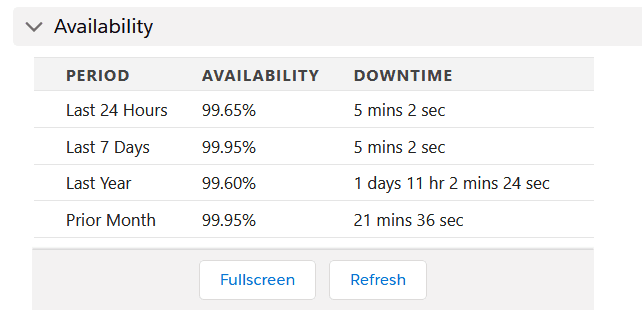Nextian tracks both service and element availability, giving account managers, support teams and others instant visibility into uptime information — directly within Salesforce.
While Operational Status reflects the current state, Availability is a statistical measure calculated from historical status data.
For example, a service may have 99.9% availability but still be down at the present moment.
| Important | Availability calculation is performed entirely by the Nextian RMM. Salesforce is responsible only for presenting the data. |
Data Model
Availability information for both services and elements is stored in the Availability_Metric__c custom Salesforce object.
Availability statistics are calculated for the following periods (Period__c field):
- Last 24 Hours
- Last 7 Days
- Last Year
- Prior Month
The rationale behind such a simplified availability model in Salesforce is as follows:
- It is easy to understand for CRM users (e.g., account managers, sales reps).
- It enables meaningful, data-driven conversations with customers, while minimizing Salesforce storage usage (Salesforce storage can incur additional costs).
- Detailed, real-time data remains available in the source monitoring system for technical users.
Calculation Logic
Availability metrics for a service are calculated as follows:
- Element probing is performed by a source monitoring system (NMS, APM, Observability or other).
- Nextian RMM retrieves monitoring data from the source system.
- Nextian RMM determines the operational status of services based on the statuses of the individual elements that make up each service.
- Based on changes in service operational status, availability statistics are recalculated in the RMM and pushed to Salesforce as aggregate values.
Accessing Service Availability Metrics
To examine service availability in Salesforce:
- Open service details.
- Scroll down to the Availability section.

Click here to learn how to examine element availability.


